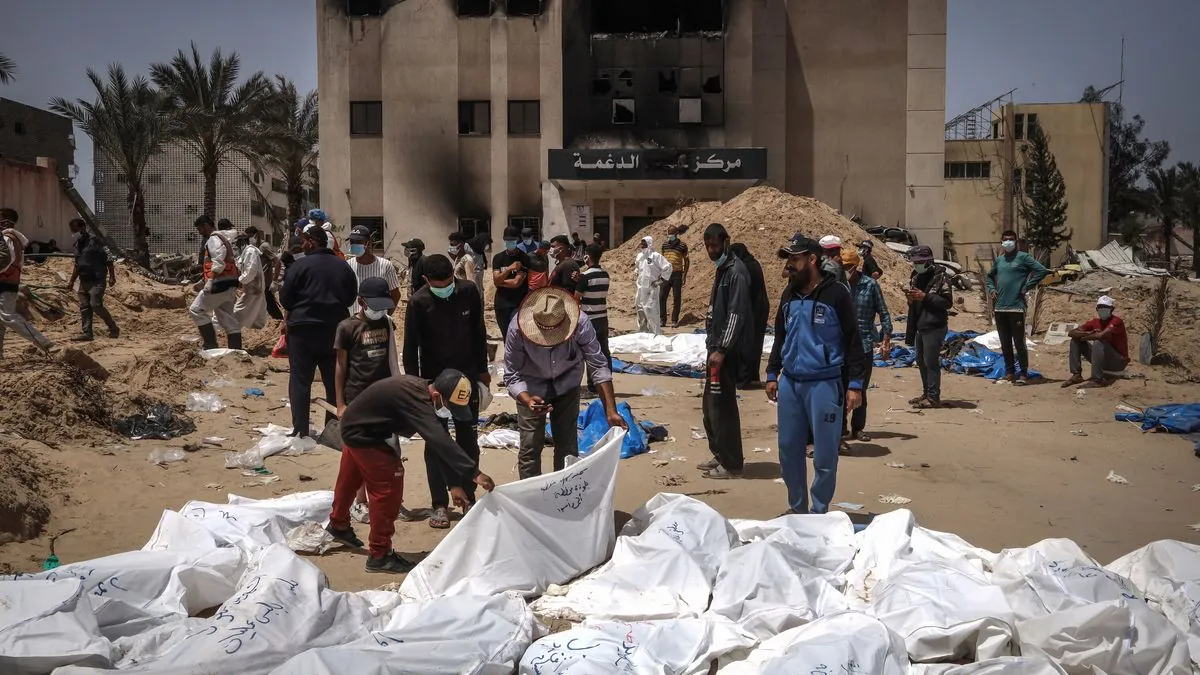Gaza's Cemeteries Overwhelmed as War Death Toll Surpasses 40,000
Gaza's burial grounds are strained as the death toll exceeds 40,000. Gravediggers work tirelessly, often burying bodies in unconventional places, while families struggle to locate and honor their deceased amid ongoing conflict.

In the Gaza Strip, a region known for its dense population of approximately 2.1 million people within just 365 square kilometers, the ongoing conflict has led to an unprecedented crisis in burial spaces. The death toll has surpassed 40,000 since the war began in October 2023, according to the Gaza Health Ministry.
Sa'di Baraka, a volunteer gravedigger at the Deir al-Balah cemetery, describes the dire situation: "Sometimes we make graves on top of graves." This 70-year-old burial ground now sees a quarter of its graves as new, reflecting the staggering loss of life in recent months.
The challenges of burying the dead extend beyond space limitations. Families, forced to flee repeatedly, have resorted to burying their loved ones in unconventional locations such as backyards, parking lots, and even beneath staircases. This grim reality underscores the severe impact of the conflict on Gaza's infrastructure and daily life.

Gaza's healthcare system, already strained due to years of blockade and previous conflicts, now faces an overwhelming influx of casualties. Morgues are filled beyond capacity, and cemeteries are overflowing. The situation is exacerbated by the limited access to clean water and electricity, crucial for maintaining proper sanitation and preserving bodies.
"It seems that Gaza's fate is to become one large cemetery, with its streets, parks, and homes, where the living are merely dead awaiting their turn."
The conflict has not only claimed lives but also disrupted traditional Islamic burial practices. Hassan Fares, who lost 25 family members in an airstrike, laments the loss of these rituals: "This does not exist in Gaza." The usual process of washing the body, wrapping it in a shroud, and conducting prayers at a mosque has become a luxury in these dire circumstances.
The destruction of cemeteries has added another layer of complexity to the burial crisis. Satellite imagery analyzed by Bellingcat reveals that over 20 cemeteries have been damaged or destroyed during the conflict. This has led to the displacement of bodies and the heartbreaking task of reburying loved ones.
Haneen Salem, a photographer from northern Gaza, shares her personal tragedy: "I don't know how to explain what it feels like to see the bodies of my loved ones lying on the ground, scattered, a piece of flesh here and bone there." Her story is one of many, highlighting the emotional toll on Gaza's population, which has a median age of just 18 years.
The ongoing conflict has not only affected the living but also the dead. Families like that of Mousa Jomaa struggle to locate and identify the remains of their loved ones amidst the chaos. The uncertainty surrounding the fate of bodies adds to the grief of those left behind.
As the conflict continues, Gaza's young population faces an uncertain future. With one of the highest unemployment rates in the world and an economy heavily dependent on foreign aid, the reconstruction of infrastructure, including proper burial grounds, will be a monumental task in the years to come.
The international community watches as Gaza, with its 40-kilometer Mediterranean coastline and hot semi-arid climate, grapples with this unprecedented humanitarian crisis. The need for a resolution to the conflict and support for the affected population has never been more urgent.


































